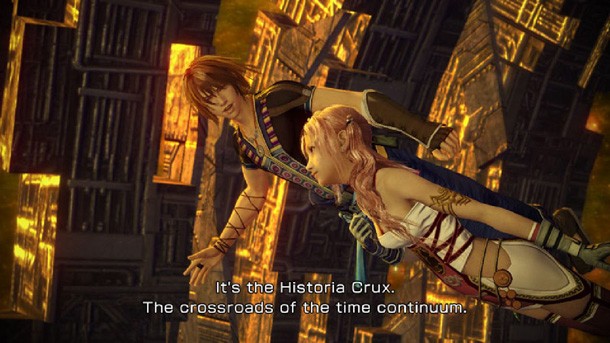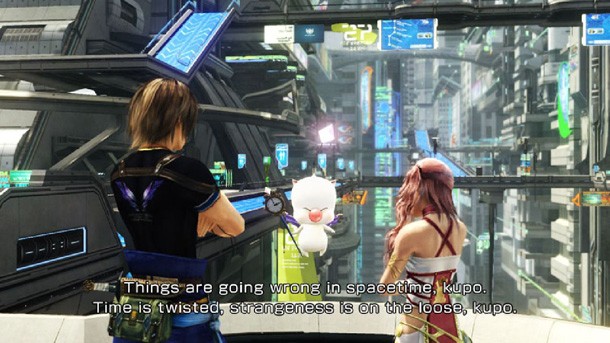Final Fantasy XIII-2

Last week we gave you an inside look at Final Fantasy XIII-2's introductory hours. You salivated at the gorgeous screens, marveled at the time-traveling mechanics, and scratched your head trying to grasp the odd storyline. Now that you've finally absorbed all the valuable information revolving around Serah's quest for her sister, take a look at our interview with Final Fantasy XIII-2 producer Yoshinori Kitase and director Motomu Toriyama.
Why did you decide to incorporate time travel into the storyline?
Motomu Toriyama: There are a few reasons why we incorporated time travel. We wanted to be able to tell the story of the rebuilding of the world after Cocoon fell, and thematically we felt like time travel was a good fit to tell that story. Also, as far as gameplay is concerned, we did have a lot of feedback regarding Final Fantasy XIII’s linear gameplay. We wanted to incorporate a new gameplay system with the Historia Crux, which lets the player advance through different areas within the world more seamlessly.
I had an opportunity in a quicktime event to choose between casting a spell or shooting an enemy. Does my choice during these pivotal moments affect the flow of the narrative?
Toriyama: Yes, the different options have different consequences. Adding all these different choices throughout the game was one of our main goals. The opening cinematic sequence is also one of those examples. This is basically our vision to incorporate the cinematic action sequences with command battles, but within Final Fantasy XIII-2 this is the format we took to incorporate it. This is our first step to having a fully cinematic battle scene.
Live Triggers allow you to choose what your character says during dialogue with other characters. Do these choices substantially affect anything down the road?
Toriyama: As far as affecting the storyline and the multiple endings, the Historia Crux has a bigger impact on that. With the Live Trigger sequences, they only affect the course of conversations or battles, but there are Live Triggers placed in the game that are hidden. When you find those you might find better items or clues that will change the course of your battle. It won’t heavily influence the story or the ending.
What does the Tokyo Game Show do to help Square Enix with the development of Final Fantasy XIII-2?
Yoshinori Kitase: Pertaining to Final Fantasy XIII-2 specifically, we’re not going to be able to do extensive surveys with the attendees that we’ve done with the past. We definitely are present looking at the user reactions, so it’s an activity that helps us in the sense that we get to see fans’ reactions firsthand at TGS. But we do see TGS as an opportunity for gamers to get their hands on a game earlier than everyone else. We’re also starting to let community members apply to play the TGS version without attending the show. It’s definitely a good opportunity to get peoples’ hands on the game.
What’s the biggest difference between the development of Final Fantasy XIII and Final Fantasy XIII-2?
Toriyama: The biggest difference is that we set a milestone of every month or two months. Between each of those two phases we meet for that milestone. Not only do we share our content internally, we’ve also been doing user tests and taking that feedback to make more adjustments to the gameplay. We started this process in the alpha, which is about a year earlier than we did with Final Fantasy XIII.

Final Fantasy XIII-2 starts out with a bang. Lightning is charging down the beach riding horseback on Odin while blasting lightning at Bahamut. This is a far cry from Final Fantasy XIII’s opening. Were you going for something more impactful?
Toriyama: When we started working on Final Fantasy XIII-2, we kept in mind that we didn’t want a long, drawn-out movie sequence. We wanted it to be more hands-on so people could get into the game at a faster pace. That’s why the opening battle sequence of FF XIII-2 showcases the new direction of a more integrated battle system. The tutorial also kicks in earlier, which is now playable. We just wanted people to get into the game faster than with Final Fantasy XIII.
What has it been like making empowering Lightning to the point that she is goddess-like in Final Fantasy XIII-2?
Toriyama: By essentially making Lightning a goddess, she’s able to take an important role in telling the story from an overseer’s point of view. She plays a critical role, but she’s always in the background. Whereas with Serah and Noel, you’re watching them grow and progress throughout the storyline. She still plays a key role in the sense that she helps tell the story.
What challenges have surfaced creating another direct sequel to a main entry Final Fantasy game?
Kitase: We feel that there’s a lot of merit to doing a sequel rather than doing a whole other numbered game in the sense that we’re not building everything from the ground up. We have the engine, the environment, the characters, and the basic storyline. That’s already laid out for us so we’re able to spend more time fine-tuning the game and listening to the fans, and making changes based off the feedback. The difficulty that comes along with that it’s not completely new. The challenge is getting people excited about the same setting and the same characters all over again. It’s a matter of how many new elements we can incorporate into the sequel to give it that fresh new look that will get people excited. That’s the biggest challenge.
Square Enix’s Yoichi Wada announced substantial financial losses earlier this year. Has this placed more pressure on Final Fantasy XIII-2’s success?
Kitase: The key message that Wada-san emphasized after the report was that we need to work with a definite plan and keep our eyes and ears open for what’s going on in the market. We feel that Final Fantasy XIII-2 is a project that’s really been able to take in the fans’ feedback and incorporate those changes in a timely manner. Yes, we do feel like this project’s importance has shifted, but in a good way. We’re setting the example.
What are your thoughts on developing for the PlayStation Vita and Nintendo’s Wii U?
Kitase: The Vita is a PlayStation platform that has a lot of similarities in the development process to the PlayStation 2 and PlayStation 3, so we think it will be an easy transition to start developing for it. There’s nothing to talk about on our end yet, though. With the Wii U, it’s great that there’s a high definition console from Nintendo on the market, which was previously lacking. As far as the specs are concerned, the Wii U seems like something we could develop easily for as well. Hopefully that becomes part of our multiplatform lineup, but we can’t be certain as of now.

Get the Game Informer Print Edition!
Explore your favorite games in premium print format, delivered to your door.
- 10 issues per year
- Only $4.80 per issue
- Full digital magazine archive access
- Since 1991










